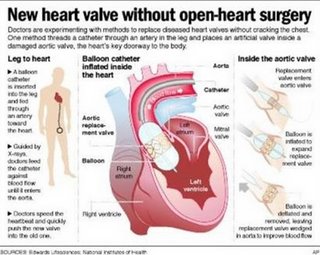
"Dr. Samuel Lichtenstein cut a 2-inch hole between an elderly man's ribs. Peering inside, he poked a pencil-sized wire up into the chest, piercing the bottom of the man's heart. Within minutes, Bud Boyer would have a new heart valve — without having his chest cracked open. Call it closed-heart surgery."I consider it some kind of magic," said Boyer, who left the Vancouver, British Columbia, hospital a day later and was almost fully recovered in just two weeks.
In Michigan, Dr. William O'Neill slipped an artificial valve through an even tinier opening. He pushed the valve up a patient's leg artery until it lodged in just the right spot in the still-beating heart.
The dramatic experiments, in a few hospitals in the U.S., Canada and Europe, are designed to find easier ways to replace diseased heart valves that threaten the lives of tens of thousands of people every year. The experiments are starting with the aortic valve that is the heart's key doorway to the body."
I thought that this was just fascinating.
Read the whole article, it is worth it."The heart has four valves, one-way swinging doors that open and close with each heartbeat to ensure blood flows in the right direction. More than 5 million Americans have moderate to severe valve disease, where at least one valve does not work properly, usually the aortic or mitral valves. Worldwide, roughly 225,000 valves are surgically replaced every year.
Topping that list is the aortic valve. It can become so narrowed and stiff that patients' hearts wear out trying harder and harder to push oxygen-rich blood out to the rest of the body.
Calcium deposits accumulate on its tender leaflets. Touch one chipped out of a patient and it feels almost like a rock.
With minimally invasive valve replacement, doctors do not remove that diseased valve. Instead, they prop it open and wedge an artificial one into that rigid doorway.
"It's ironic. You use the disease process to actually help hold your valve in place," said Lichtenstein, of St. Paul's Hospital in Vancouver, who helped create the between-the-ribs method.
Irvine, Calif.-based Edwards LifeSciences, the biggest maker of artificial heart valves, and Paris-based CoreValve are testing versions of a collapsible valve made of animal tissue that is folded inside a stent, a mesh-like scaffolding similar to those used to help unclog heart arteries.
The difference is how doctors get the new valve to the right spot, pop open its metal casing and make it stick."
4 comments:
wow. well, i do hope they get that type of procedure working successfully very soon.
a family member of mine has has open heart surgery to replace a valve and while they have recovered well considering, it is a slow, long and often painful process as the ribs take three months to knit and at least six before they are properly healed.
It is truly amazing what types of experimental heart surgeries take place. This article below is about the first newborn baby that received a cardiac implant device.
http://www3.whdh.com/features/articles/healthcast/BO13401/
This is an amazing procedure and experience for those who find science interesting, and enjoy the disocvery channel and animal planet.
Frankly, I am not one to watch operations, nor do I get particularly excited about blood and needles, but live in a home with a husband who has a passion for medicine and physics.
Hi Sarah,
My father had a triple bypass two years ago,. I am sure that he would have preferred this.
Trish,
Sounds interesting.
Barbara,
I just like to learn.
Post a Comment